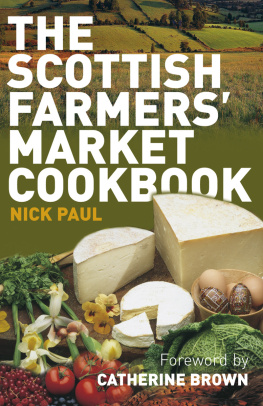A Melton Mowbray Stilton cheese produced in the town by the cheese-producing dairy of Tuxford & Tebbutt, situated on Thorpe End, Melton Mowbray. Simon Proctor is collecting the Easom Bowl, awarded for producing the finest Stilton cheese submitted at the famous Melton Mowbray Fat Stock show, December 2001. All the Stilton cheese-producing dairies would like to be awarded this cup for their cheese.
Stilton cheese being produced in 1910 in the dairy at Sutton Bonington.
INTRODUCTION TO AN HISTORIC RECORD
T here are numerous accounts on how cheese production has developed over many thousands of years. It is possible that the first type of cheese could have been made by pressing surplus milk into a bag made from fresh animal skin. When a traveller was carrying this type of bag on horseback, the animals movement and the hot sun separated the curd from the whey, and the whey drained away through a hole in the skin bag. Thus a crude cheese could have been produced.
When prepared, the curd was wrapped in a linen bag and stored on a shelf with a stone weight pressing out the surplus whey. The production of pressed cheese developed alongside unpressed cheese, and this type of cream cheese became Stilton cheese.
Many authors have written about Ermine Street, the Great North Road, and the town of Stilton providing cheese to passing trade. Travellers were using this famous highway before stagecoaches began conveying the Royal Mail in 1784. This road had developed long before the Roman occupation and was the main highway in England connecting London to Edinburgh. The only means of transporting goods and people over long distances was on horseback, or using a packhorse train. On the Great North Road as many as forty packhorses would travel in line tail to tail. The junction town of Stilton was a centre catering for horse riders, packhorses and drovers travelling for long distances along recognised routes, and many centred on this terminus on the road to London where refreshment could be obtained: bread, cheese and rough beer.
A Stilton cheese stand promoting the Bell Inn at Stilton.
In 1635 Charles I commanded that a post should be set up between London and Edinburgh. Mail was to be conveyed by the post boy on horseback, stopping to change horses at the first stopping point at Stilton, seventy miles north of London.
As of 1985, local historians living in the village of Stilton who were involved with The Bell Inn stated that the publican and trader Cooper Thornhill, who purchased this inn in 1730, conveyed Stilton cheese to London by stagecoach. A carved wooden display features this famous trader with said stagecoach. Cooper Thornhill died in 1759 and he certainly would have conveyed Stilton cheese using horses to London. Twenty-five years later, in 1784, the first stagecoach runs commenced on the Great North Road.
Over the last two decades, myths and legends have expanded, and many errors have been published, especially on the internet. It is on record that when the London Express halted at The Blue Bell Inn at Stilton in the 1780s, those passengers who could afford it were offered Mrs Pawletts cheese. Frances Pawlett expanded her business on her husbands death in 1787. Not only did she produce Stilton cheese, she also sold it extensively in the East Midlands and London, taking over the trade that Cooper Thornhill had developed with her late husband. She also factored Stilton cheese into the weekly markets held in Melton Mowbray. Frances was living in a male dominated society. Women stood little or no chance of obtaining a controlling position in the world of finance and marketing in the eighteenth century, unless she was born into a royal house or married someone who was part of the ruling class. Frances Pawlett was one of the very few exceptions. Working with her second husband, William, until his death in 1787, she developed an exceptional cream cheese, which was popular with the ruling class in London. She became a leading figure in marketing her Stilton cheese for the next ten years. Local wealthy landowners, on her husbands death, opposed her marketing skills. She rose above these bigoted farmers, who dominated their wives and daughters, and found her place in history.
A standard press developed to produce pressed cheese. No presses are used in the production of modern Stilton cheese. This cheese is consolidated through its own weight. If any pressure was applied the blue middle effect would not develop. Compare this drawing with the photograph on page 94.
In the 1930s a movement began to recognise Frances Pawlett as one of the women in the eighteenth century who had contributed to the impact on how women had contributed so much in modern society. Certainly a national newspaper,














